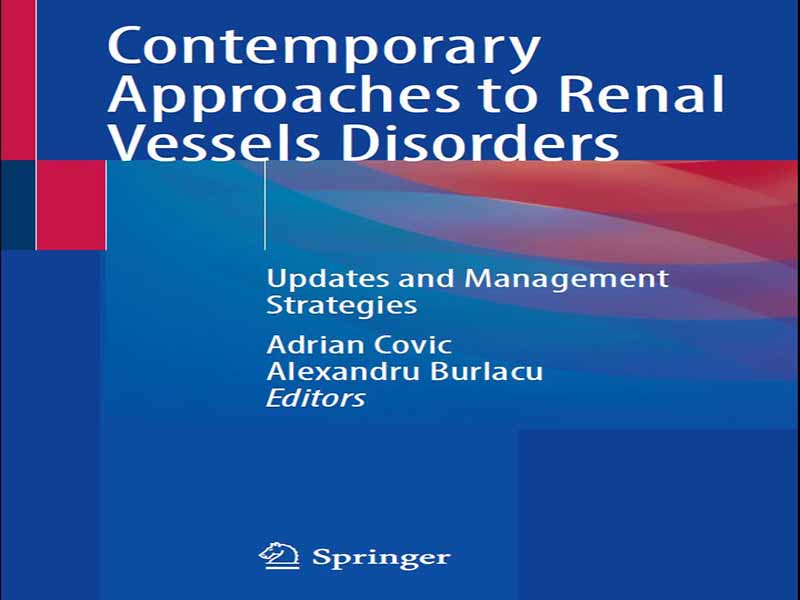- عنوان کتاب: Contemporary Approaches to Renal Vessels Disorders
- نویسنده: Adrian Covic, Alexandru Burlacu
- حوزه: بیماری کلیه
- سال انتشار: 2025
- تعداد صفحه: 160
- زبان اصلی: انگلیسی
- نوع فایل: pdf
- حجم فایل: 4.84 مگابایت
فشار خون شریانی یک عامل خطر اصلی برای مرگ و میر قلبی عروقی است که شیوع بسیار بالایی در بین بیماران مبتلا به بیماری کلیوی دارد. وجود فشار خون بالا پیشرفت آسیب کلیوی را تسریع میکند، در حالی که خود بیماری کلیوی میتواند منجر به فشار خون بالا شود و یک چرخه معیوب مضر ایجاد کند. هر دو بیماری با هم همکاری میکنند تا توسعه و پیشرفت بیماریهای قلبی عروقی را تقویت کنند. با وجود شواهد روشن، نقش عروق کلیوی در این فرآیندها اغلب دست کم گرفته شده و به خوبی درک نشده است. فراتر از فعال شدن سیستم رنین-آنژیوتانسین و سیستم عصبی خودکار، تحقیقات اخیر مکانیسمهای بیوشیمیایی و مولکولی جدیدی را که زمینهساز آسیب کلیه در فشار خون بالا هستند، کشف کردهاند. آسیب به میکروسیرکولاسیون کلیوی با افزایش استرس اکسیداتیو، اختلال عملکرد اندوتلیال و حالت مزمن عفونت تحت بالینی همراه بوده است. درک این مکانیسمها، که زمینهساز نفروانژیواسکلروز ناشی از فشار خون بالا هستند، منجر به تحقیقات جدیدی برای کنترل این عوامل شده است. علاوه بر میکروسیرکولاسیون، بیماریها و ناهنجاریهای عروق بزرگ شریانی و وریدی کلیوی میتواند منجر به شرایط پاتولوژیکی شود که سلامت سیستمیک را تهدید میکند. پیشرفتهای چشمگیری در شناسایی و درمان زودهنگام این شرایط حاصل شده است. رویکرد به بیماری نفرواسکولار آترواسکلروتیک با تأکید بر بهینهسازی مداخله دارویی و حفظ عروق برای موارد منتخب، مطابق با اصول پزشکی شخصیسازیشده بر اساس وضعیت بالینی بیماران، تکامل یافته است. پیوند کلیه و مشکلات عروقی کلیوی مرتبط با آن نیز از مباحث حیاتی هستند. پیوند کلیه اغلب به عنوان درمان انتخابی برای بیماران واجد شرایط مبتلا به نارسایی کلیه در نظر گرفته میشود و مزایای متعددی نسبت به دیالیز، مانند کاهش خطر مرگ و میر، امید به زندگی طولانیتر و بهبود کیفیت زندگی، ارائه میدهد. با این حال، عوارض عروقی در پیوند کلیه، از جمله تنگی شریان کلیوی پیوندی، ترومبوز و آسیبهای عروقی ناشی از بیوپسی، همچنان نسبتاً شایع هستند و میتوانند منجر به آسیب آلوگرافت شوند. درک این عوارض و ملاحظات عروقی پیرامون عمل برای بهبود نتایج بیمار و بقای پیوند ضروری است. در نهایت، دستورالعملهای اخیر از انجمنهای علمی فشار خون بالا، بر اساس آخرین کارآزماییهای تصادفی، اهمیت تکنیکهای قطع عصب کلیه را برای درمان اشکال مقاوم فشار خون بالا تجدید کردهاند. علاوه بر این، شواهد جدید نشان میدهد که قطع عصب کلیه ممکن است مزایایی فراتر از درمان فشار خون مقاوم داشته باشد و بر بیماریهای کلیوی، آریتمی و متابولیک تأثیر بگذارد. این کتاب که توسط دو متخصص در این زمینه، پروفسور آدریان کوویچ و پروفسور الکساندرو بورلاکو، هماهنگ شده است، به همه این مباحث میپردازد و مروری جامع بر موضوعاتی که اغلب به اندازه کافی شناخته و مورد توجه قرار نمیگیرند، ارائه میدهد. هدف این کتاب، ارائه منبعی ارزشمند از دانش و مداخله بالینی، نه تنها برای متخصصان نفرولوژی، بلکه برای متخصصان قلب و عروق و پزشکانی است که با بیماریهای متابولیک سروکار دارند.
Arterial hypertension is a major risk factor for cardiovascular mortality, with an extremely high prevalence among patients with renal disease. The presence of hypertension accelerates the progression of renal damage, while renal disease itself can lead to hypertension, creating a harmful vicious cycle. Both conditions synergize to promote the development and progression of cardiovascular disease. Despite clear evidence, the role of renal vasculature in these processes is often underestimated and poorly understood. Beyond the activation of the renin–angiotensin system and the autonomic nervous system, recent research has uncovered new biochemical and molecular mechanisms underlying kidney damage in hypertension. Damage to the renal microcirculation has been associated with increased oxidative stress, endothelial dysfunction, and a chronic state of subclinical infection. Understanding these mechanisms, which underlie hypertensive nephroangiosclerosis, has led to new research to control these factors. In addition to microcirculation, diseases and abnormalities of the renal large arterial and venous vessels can lead to pathological conditions that threaten systemic health. Significant advances have been made in the early identification and treatment of these conditions. The approach to atherosclerotic nephrovascular disease has evolved, emphasizing the optimization of pharmacologic intervention and reserving revascularization for selected cases, in line with personalized medicine principles based on the clinical condition of individual patients. Kidney transplantation and its associated renal vascular issues are also critical topics. Kidney transplantation is often considered the treatment of choice for eligible patients with kidney failure, offering numerous advantages over dialysis, such as decreased mortality risk, longer life expectancy, and improved quality of life. However, vascular complications in renal transplantation, including transplant renal artery stenosis, thrombosis, and biopsy-induced vascular injuries, remain relatively common and can lead to allograft damage. Understanding these complications and the perioperative vascular considerations is essential for improving patient outcomes and graft survival. Finally, recent guidelines from hypertension scientific societies have renewed the importance of renal denervation techniques for treating resistant forms of hypertension, based on the latest randomized trials. Additionally, new evidence suggests that renal denervation may provide benefits beyond treating resistant hypertension, impacting renal, arrhythmic, and metabolic diseases. This book, coordinated by two experts in the field, Prof. Adrian Covic and Prof. Alexandru Burlacu, addresses all these topics, providing a comprehensive overview of subjects that are often insufficiently known and considered. It aims to be a valuable resource of knowledge and clinical intervention, not only for nephrologists but also for cardiologists and physicians dealing with metabolic diseases.
این کتاب را میتوانید بصورت رایگان از لینک زیر دانلود نمایید.
Download: Contemporary Approaches to Renal Vessels Disorders



































نظرات کاربران